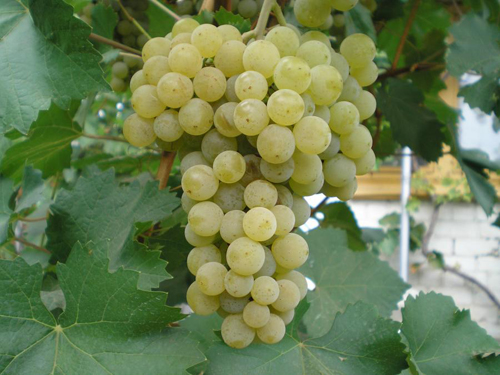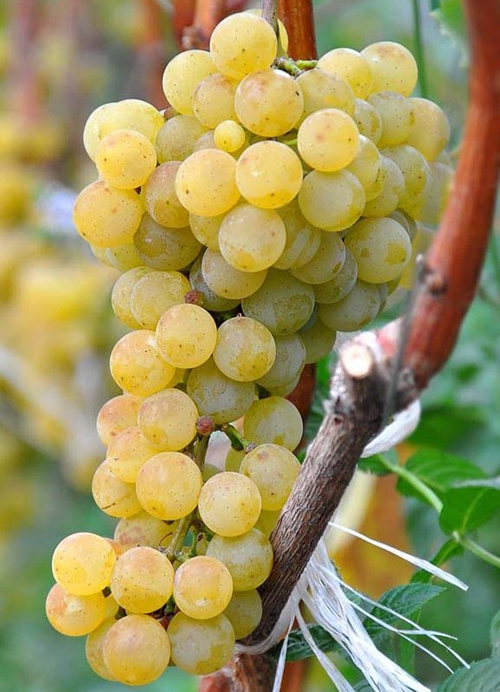Grape variety Citron Magaracha
Classic European grape varieties intended for the production of wines, with all their high quality, have a significant drawback - they are more or less susceptible to fungal diseases. This fact makes their cultivation troublesome, laborious and costly enough. For a century and a half, since the emergence of the most harmful diseases in Europe, many breeders have been struggling to develop varieties that are resistant to these pathogens. Initially, scientific thought went along the path of creating interspecific combinations with American varieties of grapes acting as donors of resistance genes - the so-called "hybrids of direct producers". However, most of them were not to the taste of spoiled European gourmets, as they resulted in low-quality flat, faceless wines with a typical bitterness and, according to some sources, increased content of methyl alcohol and diglycosides.

The elimination of these contradictions, and the creation of stable and high-quality hybrids at the same time, was devoted to a lot of scientific research, including in our country. And, it should be noted that this work was not in vain - many research institutes of viticulture and winemaking in the post-Soviet space have varieties that meet these high requirements to one degree or another. One of them is Tsitronny Magarach, a selection of the oldest national research center - NIIViV "Magarach" from Yalta.
The grapes were bred in the 70s of the last century by a complex crossing of the French variety Madeleine Angevin with the promising form Magarach No. 124−66−26 and Novoukrainsky early. The authors of the novelty are scientists of the institute: Kireeva L.K., Volynkin V.A., Malchikov Yu.A., Usatov T., Troshin P.V. and Oleinikov V.L. Distinctive features of Citron Magarach are excellent resistance to mildew, oidium and gray rot, tolerance to phylloxera, increased frost resistance, very high yield, as well as a relatively large size of bunches for technical grapes, which greatly facilitates and speeds up their collection. The quality is eloquently evidenced by the fact that the White Muscatel wine made from it won many medals and cups at international competitions just a few years after its appearance.
Thanks to such a complex set of positive qualities, Citron Magaracha was deservedly included in the State Register of Plant Varieties Permitted for Industrial Cultivation, Ukraine in 2002, and in the State Register of Breeding Achievements of the Russian Federation in 2004, where it was allowed to grow in the North Caucasian region (Republic of Ingushetia, Crimea, Kabardino-Balkarian, Chechen, North Ossetia-Alania, Adygea, Dagestan, Rostov region, Stavropol and Krasnodar territories).

Agrobiological characteristics
Bushes of Citron Magarach are medium or vigorous. Young shoots are light green, and ripe ones are dark red. In autumn, the foliage becomes yellow in color. The leaf is medium, rounded, usually three-lobed, slightly dissected, bright green in color. The surface of the leaf blade is smooth, shiny, there is no pubescence on the dorsum. The lateral notches are shallow, V-shaped or barely outlined. The petiole notch is open, lyre-shaped, with a pointed bottom. The petiole has a pink tint, approximately equal in length to the main vein. The teeth along the edge of the lobes are large, triangular with sharp tops and a wide base. The flowers are bisexual. Pollination is excellent.
Bunches of Citron Magarach are large enough for technical grapes of size - up to 18 cm long and weighing 250-400 grams, conical or cylindro-conical, winged, medium density.The combs are quite long, strong, like the leaf petioles, they are slightly pink in color, the stems of the berries are of medium length or short. The berries are medium in size, round, greenish or straw yellow in color. The mass of 100 berries is 230-250 grams. The pulp is tender, juicy with a pronounced specific citron-nutmeg aroma. The skin is thin, firm, covered with a faint whitish waxy coating. The stones are medium in size, oval in shape, their number reaches 3-4. The technological composition of the bunch of this variety is as follows: juice - 69%, skin, seeds and dense parts of the pulp - 24%, ridges - up to 7%. Berry cracking and berry decay is not observed even in very humid years, however, damage by wasps can occur, which are attracted by the sweet taste and strong aroma of the grapes.
The harvest is intended for processing into high quality table and dessert wines. The bouquet of these drinks is invariably bright with memorable tones of flowers and lime. The taste is drinkable, light, harmonious and harmonious. Light straw color, possible with a slight pinkish tint. The content of ethyl alcohol in dry table wines is 10-11% by volume, titratable acids - 5.2-5.6 grams / cubic dm. Tasting assessment of dry wine - 7.8 points, dessert - 7.9 on an 8-point scale. At the same time, excellent non-alcoholic drinks - juices and compotes, which will also absorb an unforgettable varietal aroma - can be obtained from Citron Magarach.

The ripening period of grapes is early-medium, with a growing season from bud break to the onset of removable ripeness of 120-130 days and the required amount of active temperatures of 2600-2700 ° C. At home, in the Crimea, the technical ripeness for the production of table wine materials usually falls on the end of August and the beginning of September. However, if you extend these periods, leaving the bunches hanging on the bushes for a couple of weeks, you can get the maximum possible conditions for sugar accumulation in the berries, which will make them an excellent raw material for making dessert drinks.
The yield is stable and very high. In a variety trial, Citronny Magaracha showed an average productivity of 138 centners / ha, however, producers receive up to 200 centners from it. The frost resistance of the aboveground part of the bush is quite high (-25 ° C), which allows it to grow in traditional areas of industrial grape production without shelter for the winter. The fruitfulness of the developed shoots is high, sometimes even excessive, which requires taking measures to normalize the crop. Also, the variety is characterized by high productivity of the lower eyes, which eliminates the need for long pruning of fruit arrows. Ripening of shoots in autumn is excellent, provided that the crop is not overloaded with the bushes. The sugar content of the juice of berries at early stages of harvesting is 19-20%, at late periods - up to 26%; acidity - about 5-6 grams / liter.
Agrotechnical features
To grow Citron Magarach and obtain bountiful harvests on it, it will not require excessive efforts beyond those that must be applied in any vineyard. Planting can be carried out with self-rooted seedlings even in areas of soil contamination with phylloxera, due to the variety's tolerance to this pest. Reproduction by grafted seedlings will be required only on heavy-textured soils, where phylloxera feels especially at ease, and even tolerant varieties can hardly tolerate its presence, lagging behind in growth and yield from grafted counterparts. The feeding area of the bushes should be about 6 square meters, that is, with a row spacing of 3 meters, the distance between plants in a row will be 2 meters.
The grapes quickly enough enter the season of fruiting, and already in the third year the skeleton of the bush is formed, in connection with which it is necessary to decide on the chosen formation before that time. In most wine-growing regions, the variety is grown on a tall trunk in a non-covering culture, which allows free placement of annual growth, enhancing, due to the inherent polarity of plants, the generative component.However, in amateur plantings in frost-prone places that are not traditional for viticulture, it is required to form a Citron Magarach bush, taking into account the convenience of removing it from the trellis in the fall to provide shelter for the winter. In this case, such forms of bush management as a multi-arm fan or an inclined cordon are suitable.
Pruning in the spring is carried out shortly - by 3-4 eyes, while in general, 30-40 buds are left on the grape bush, depending on its condition, growth strength and the chosen formation. During the growing season, the load is additionally regulated by the debris of sterile and weak shoots, as well as by removing unnecessary clusters on those shoots where more than two of them have formed. With vertical placement of one-year growth, it is advisable to carry out minting in order to redistribute plastic substances, improving the technological quality of the crop and ripening of the shoots.
The processing of Citron Magarach from fungal diseases requires a minimum - one or two preventive spraying during the periods of their greatest harmfulness. Certain efforts will be required to control the number of grape rolls, against which permitted insecticides are used, and wasps, which can be dealt with using special traps.
Given the high potential productivity of the variety, in arid regions it responds very well to watering, significantly adding in the size and weight of the bunches without compromising their quality.
The timing of harvesting must be chosen in accordance with the type of wine material that is planned to be produced from the grapes. For the production of dry table drinks, you should not overexpose the berries on the bush, since excessive sugar accumulation will inevitably lead to an increased content of the volume fraction of alcohol, depriving them of the lightness for which white wines are valued. Dessert ones, on the contrary, only become better and richer with an increase in the sugar content of the raw materials, which requires much later grape harvesting dates. But, whatever the direction of processing the harvest of Citron Magarach in the end, its cultivation will give the winegrower only positive emotions, since rarely what variety can compare with our hero in terms of the degree of unpretentiousness, plasticity, yield and technological characteristics of the fruit.








